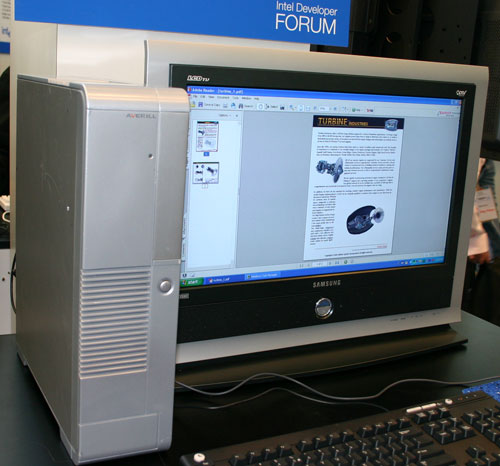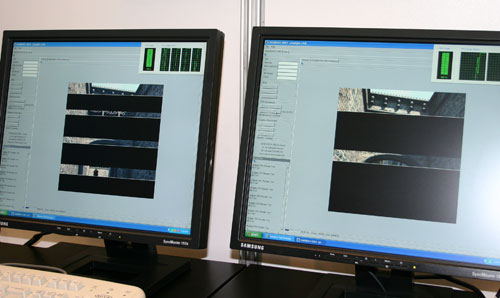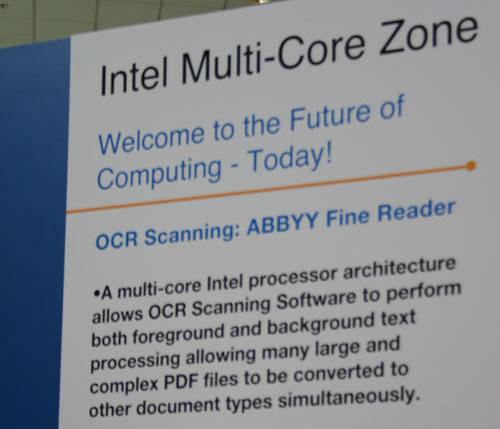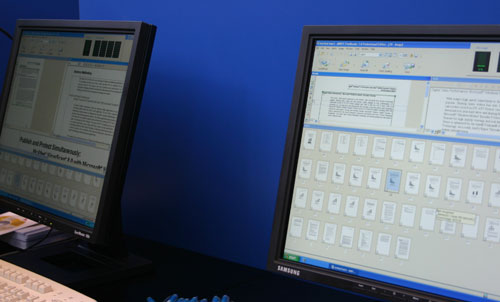Updated! IDF Spring 2005 Day 1 - 65nm Multi-Core Demos and more
by Anand Lal Shimpi on March 1, 2005 4:10 PM EST- Posted in
- Trade Shows
More Dual Core
The office BTX platform from this morning's keynote was also present for closer inspection, showing that dual core also has some use in the office - although granted there were no office performance demonstrations showcasing dual core vs. single core systems...for obvious reasons.

Intel did put together some relatively decent demos showcasing the benefits of dual core, the first was a video rendering test. Two systems rendered a single frame, one system was a Pentium 4 3.73EE, the other was a Pentium 4 3.2EE Dual Core. In this particular test, the dual core CPU rendered the scene in 45 seconds, compared to 67 seconds of the single core, higher clocked, Pentium 4 3.73EE.

There was also a demo of OCR software converting images into PDFs, once again using the two Pentium 4 EE processors from above. The dual core processor, despite a lower clock speed, managed to fly through the conversion about twice as quickly as the single core chip.


Obviously both of the aforementioned examples are demos constructed to show dual core in the best possible light, but they are gains that can be achieved once software takes advantage of dual and multi core configurations.
Intel also had a proof of concept game engine running that used multithreading to improve physics performance. Epic and id will evcentually have multithreaded game engines in their games, but we're at least another year or two away from that happening.
Final Words
Next up we've got Pat Gelsinger's keynote at IDF. Gelsinger usually has some very interesting keynotes, even if they aren't always things we can really write about. The keynote starts in half an hour, so expect an update within the next two hours.










21 Comments
View All Comments
mikecel79 - Tuesday, March 1, 2005 - link
#5 I noticed it to.AtaStrumf - Tuesday, March 1, 2005 - link
Ups, this is a NEW article. Darn it, I sure messed up this time - LOL.coldpower27 - Tuesday, March 1, 2005 - link
Were also quite a bit away from the 65nm process still, so we still don't know what may happen in between that time frame.Doormat - Tuesday, March 1, 2005 - link
Yes, current leakage due to the smaller manufacturing process will increase at 65nm over 90nm, SOI helps, and strained Si increases the amount of current the processor uses (so transistors can be switched quicker, the chip clocked higher). Leakage has been increasing forever, every process shrink caused it to go up, but the problem is that it seems to be governed by an exponential function. It was small for a while, but now its increasing at a drastic rate. When Intel expected 4.5GHz out of a 90nm processor, now they're stuck at 3.8GHz, mostly because of leakage (and the way the P4 is designed didnt help much). The mobile core is better, but it was designed to not consume lots of power. Look at that HSF unit on the 65nm Jonah processor. You arent getting that into a notebook anytime soon (Jonah is a decendant of Banias, so thats why I put that in the frame of reference of a notebook PC).And AMD isnt in much better of a boat, since the new TDP of the newest stepping of the Opteron is 90W (2.6GHz). AMD's dual cores may top out at 2GHz.
AtaStrumf - Tuesday, March 1, 2005 - link
It seems quiet because posts are getting deleted as article gets updated. - LOLWe had a first post and a stupid russian joke when I was last here.
And there was this, let's say, interesting Moore's Law picture, that I was surprised nobody commented on. Let's just say that it looked like the guy had got an erection on the 65nm process - LOL.
Questar - Tuesday, March 1, 2005 - link
#2,65nm is a new manufaturing process. What part of new is it you don't get?
Sure is quiet in here. AMD fanbois gone licking their wounds?
Phiro - Tuesday, March 1, 2005 - link
Hey, is it just me or is the site kinda acting weird? I have to frequently refresh pages to get the body of articles to show up, and with the last two articles the text is invisible until I highlight it.overclockingoodness - Tuesday, March 1, 2005 - link
Dang! AnandTech is really doing live reporting from the show floor. Another update in the next two hours...WOW!SocrPlyr - Tuesday, March 1, 2005 - link
#2first offIntel's 65nm is supposed to include SOI, something the 90nm doesn't include, so that should help. (correct me if i am wrong)
Next there are advantages for smaller processes. First off you can pack more transistors into the same size chip, also those transistors can run faster because of the reduced delay times (mainly from the reduced parasitic capacitances from the transistor size)
Josh
sprockkets - Tuesday, March 1, 2005 - link
since 90nm has more leakage, and 65nm is just going to be worse, what's the big deal or the hype or the happy expectation of a processor that will leak and waste even more power?